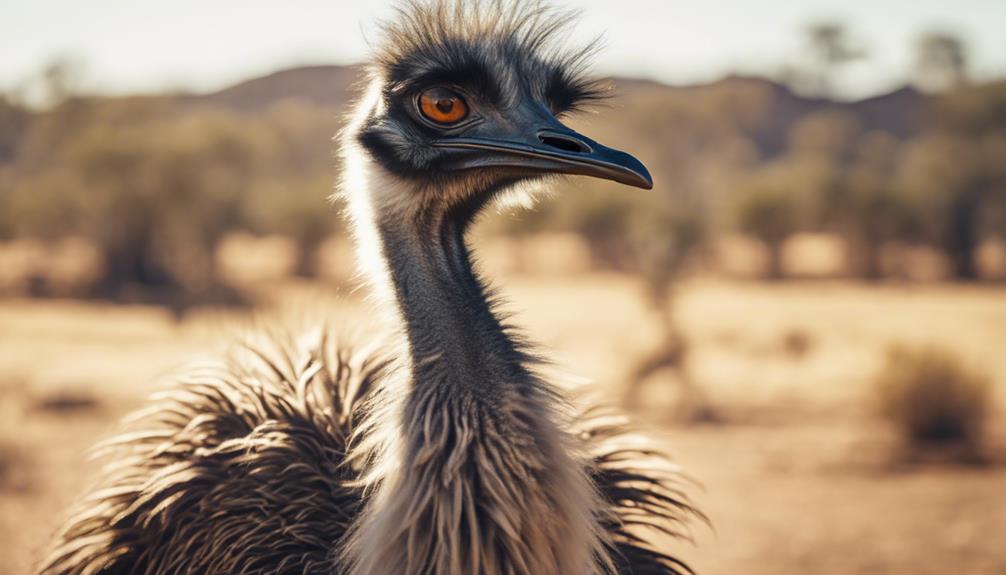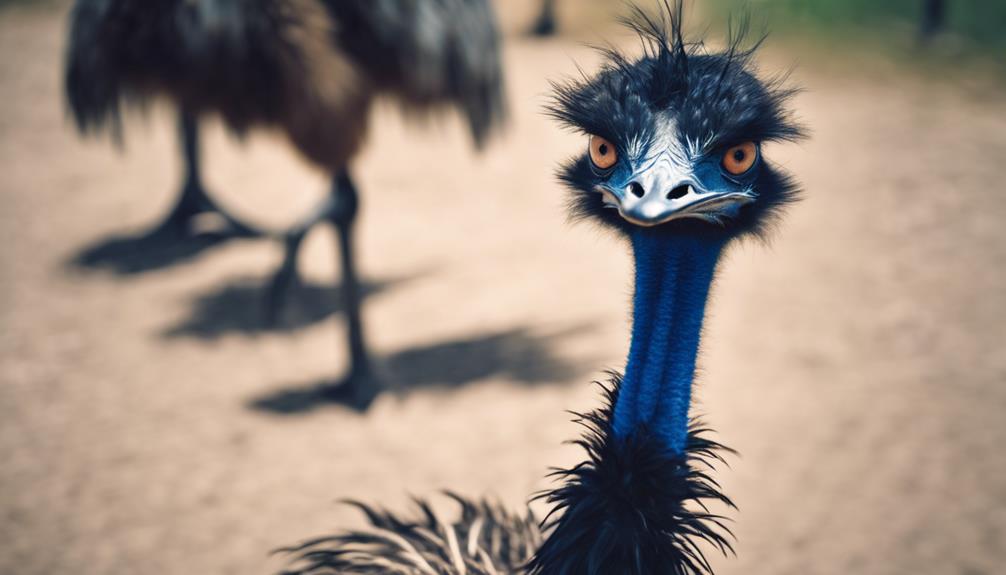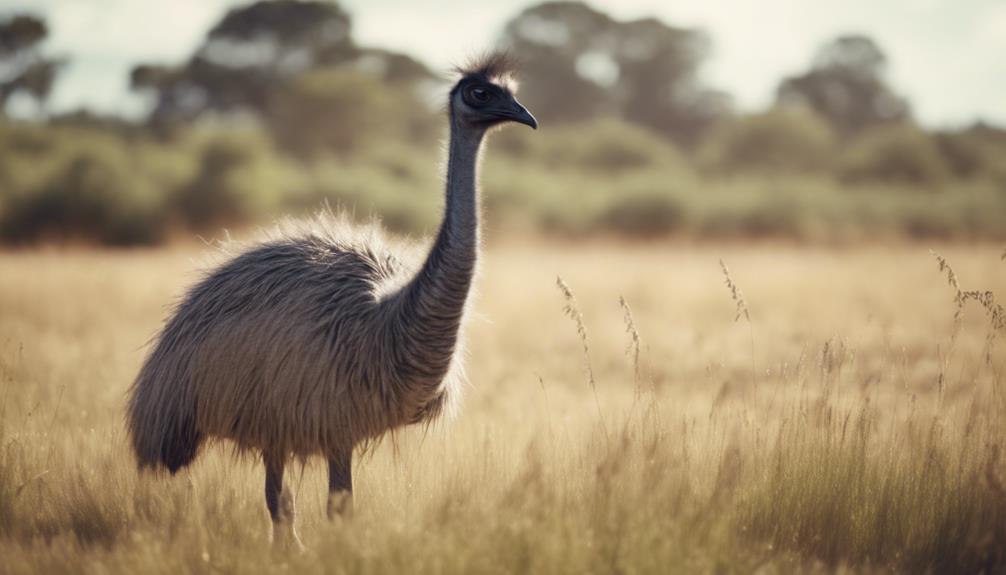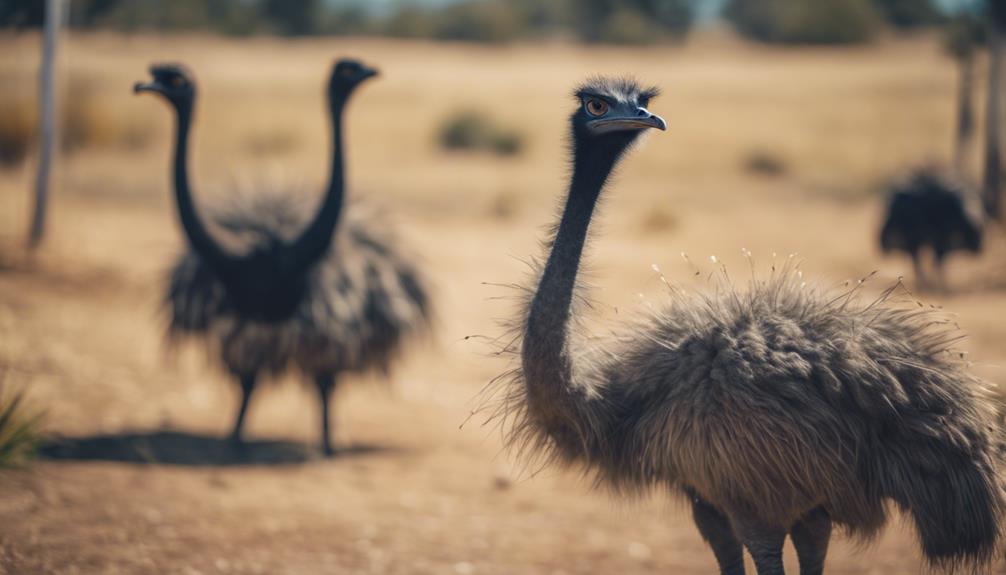
As you gaze upon the vast Australian landscapes, the sight of emus gracefully traversing the terrain might evoke a sense of curiosity about these ancient creatures. Their presence holds a silent narrative of resilience and adaptation, standing as testament to the intricate dance between time and evolution. But what secrets lie within their distinctive features and behaviors, shaping their existence in ways that defy the conventional norms of avian life?
Key Takeaways
- Emus have existed for around 30 million years.
- They are descendants of ancient ratites.
- Emus possess ancient physical features for survival.
- Emus play a significant ecological role in the ancient landscape.
- Emus have evolved unique adaptations over time.
Emus: A Brief Overview

Emus, known scientifically as Dromaius novaehollandiae, are large flightless birds native to Australia with long legs and distinctive blue-grey feathers. These majestic creatures can reach heights of up to 6.2 feet (1.9 meters) and weigh between 66 to 121 pounds (30 to 55 kilograms). Their bodies are adapted for swift running, with strong, sturdy legs that enable them to reach speeds of up to 30 miles per hour (48 kilometers per hour).
One of the most striking features of emus is their unique call, a booming sound that resonates across the Australian landscape. Their diet consists mainly of plants, fruits, insects, and small animals, making them omnivores with a diverse palate. Emus are known for their resilience and adaptability, thriving in a range of habitats from forests to grasslands to deserts.
Origins of Emus
The origins of the emus can be traced back to ancient times, revealing a fascinating evolutionary history that sheds light on their unique characteristics and adaptations. Emus belong to the ratites group, which includes flightless birds like ostriches and kiwis. The earliest fossil records of emus date back to around 30 million years ago, showing their long-standing presence on Earth. Through the process of natural selection, emus have developed specific traits that have allowed them to thrive in their environment.
Emus are well-adapted to the Australian landscape, with their long legs built for running at high speeds, enabling them to escape predators and cover vast distances in search of food and water. Their vestigial wings, which are no longer used for flight, have evolved into sturdy structures that aid in balance and communication. Additionally, their powerful beaks are specialized for foraging and feeding on a variety of vegetation and insects. The evolutionary journey of emus showcases the incredible resilience and adaptability of these ancient creatures.
Physical Characteristics of Emus

What physical characteristics distinguish emus from other bird species?
Emus, majestic creatures of the land, possess distinct features that set them apart. Standing tall at around 6.2 feet (1.9 meters), emus are the second-largest birds globally, with strong, sturdy legs that support their impressive height.
Their long necks are adorned with small, sharp beaks ideal for foraging. Emus boast a unique set of feathering, with soft, dense plumage that ranges in color from brown to gray. Notably, their lack of a tail, a rare trait among birds, contributes to their streamlined appearance.
These flightless birds have powerful, three-toed feet, each toe equipped with a sharp claw, aiding in defense and foraging. Emus' keen eyesight allows them to spot threats from afar, while their swift running ability, reaching speeds of up to 30 mph (48 km/h), aids in evading danger.
These physical attributes collectively make emus formidable and fascinating creatures of the Australian landscape.
Emu Habitat and Distribution
In the vast expanse of the Australian landscape, emus inhabit a diverse range of habitats, displaying a remarkable adaptability to varying environmental conditions. Emus are primarily found in the open country, including savannas, woodlands, and coastal areas. They're known to thrive in regions with sparse vegetation, as their long legs enable them to cover great distances in search of food and water. Emus have also been observed in more arid regions, where they utilize their keen sense of smell to locate water sources.
These majestic birds are widely distributed across Australia, with populations concentrated in the eastern, northern, and southwestern parts of the continent. Emus can be found in Queensland, New South Wales, Victoria, South Australia, and Western Australia. Their distribution is often influenced by factors such as food availability, water sources, and nesting opportunities. Despite their ability to adapt to various habitats, emus tend to avoid dense forests and urban areas. Overall, the emu's habitat and distribution highlight their resilience and ability to thrive in diverse environments.
Emu Diet and Feeding Habits

Emus regularly forage for a diverse array of plant matter and insects to sustain their nutritional requirements. Their diet consists of grasses, fruits, seeds, and flowers, providing essential vitamins and minerals. These powerful birds use their sharp beaks to pick and consume various plant species, showing a preference for fresh vegetation. Additionally, emus are opportunistic feeders, often consuming insects like beetles, grasshoppers, and caterpillars when available. This diverse diet ensures they meet their energy needs and maintain optimal health.
Observationally, emus exhibit efficient feeding habits, using their long necks to reach vegetation at different heights. They graze throughout the day, covering large areas in search of food. Emus display a keen sense of food selection, often avoiding toxic plants and opting for safer alternatives. Their feeding behavior is strategic, enabling them to thrive in various habitats. By incorporating a wide range of foods into their diet, emus showcase their adaptability and prowess as ancient creatures of the land.
Emu Reproduction Cycle
As emus continue their daily activities, a notable aspect of their life cycle unfolds in the intricacies of their reproduction process. Emus, known for their large size and distinctive appearance, engage in a fascinating reproductive cycle governed by precise biological mechanisms. The female emu plays a dominant role in this process, as she carefully selects a mate based on various factors such as health and physical attributes.
During the breeding season, which typically occurs in the cooler months, the male emus compete for the attention of the females through elaborate courtship displays. These displays involve puffing up their chests, emitting deep booming sounds, and performing intricate dances to impress potential mates.
Once a female has chosen a mate, she'll lay several dark green eggs in a shallow nest prepared by the male. The male emu then takes on the responsibility of incubating the eggs for approximately 8 weeks, during which he doesn't eat, relying solely on stored fat reserves.
After the eggs hatch, the male cares for the young emus, known as chicks, teaching them essential survival skills until they're independent enough to fend for themselves. This intricate reproduction cycle highlights the remarkable instincts and behaviors of these ancient creatures.
Behavioral Patterns of Emus

Behaving in a manner reflective of their evolutionary adaptations, emus exhibit intricate and fascinating behavioral patterns that contribute to their survival in their natural habitat. Emus, as flightless birds, have evolved to rely heavily on their keen senses and swift running abilities to avoid predators and find food. One striking behavioral pattern is their communal nesting behavior, where several females lay eggs in a single nest, allowing for shared incubation duties and increased protection against threats.
Emus are known for their nomadic lifestyle, constantly on the move in search of food sources. They exhibit a curious and exploratory nature, often investigating new objects or environments they encounter. This behavior not only helps them find potential food but also aids in their understanding of their surroundings, enhancing their survival skills.
During mating season, male emus perform elaborate courtship displays to attract females, showcasing their fitness and strength. The dominant male will then take on the responsibility of incubating the eggs, showing a rare reversal of parental roles in the animal kingdom. These behavioral patterns of emus highlight their adaptability and intelligence, crucial for thriving in their challenging environment.
Emus in Indigenous Culture
In examining the cultural significance of emus, it becomes evident that these ancient creatures hold a revered place in Indigenous traditions and beliefs. Emus aren't merely seen as animals in Indigenous culture; they symbolize strength, resilience, and wisdom. Their presence in creation stories underscores their importance as spiritual beings that are deeply connected to the land.
Emus feature prominently in Indigenous art, often depicted in intricate dot paintings and carvings. These representations serve as a reminder of the deep respect Indigenous communities hold for these majestic birds. Additionally, emus are a vital source of food, feathers, and materials for various tools, further emphasizing their practical and symbolic value in Indigenous life.
Furthermore, the distinctive drumming sound made by male emus during mating season is believed to have spiritual significance, signaling the renewal of life and the continuation of traditions. This primal sound is a powerful reminder of the ancient bond between emus and Indigenous peoples, highlighting the enduring legacy of these remarkable creatures in Indigenous culture.
Emus Vs Ostriches: Key Differences

Emus and ostriches differ significantly in various physical characteristics and behavioral traits, distinguishing them as distinct species of flightless birds. One notable difference is their size; ostriches are larger and heavier, standing as the tallest and heaviest birds globally. Emus, while still sizable, are smaller in comparison. In terms of appearance, emus have a more prominent neck with a distinctive blue skin, while ostriches possess a pinkish neck. Their feathers also vary, with emus having a more shaggy and darker plumage compared to the smoother and lighter feathers of ostriches.
Behaviorally, emus are known to be more solitary creatures, often foraging and moving alone or in small groups. Ostriches, on the other hand, are more social birds that live in flocks. When it comes to breeding habits, emus exhibit a polyandrous mating system, where the female mates with multiple males, while ostriches have a polygynous mating system where the male mates with multiple females. These differences in physical characteristics and behaviors highlight the unique adaptations each species has developed to thrive in their respective environments.
Emus and Their Predators
Amidst the vast Australian landscape, emus face a variety of predators that play crucial roles in shaping their behaviors and survival strategies. These predators have contributed to the evolution of the emu's keen sense of awareness and agility in navigating their environment.
- Dingoes: As apex predators, dingoes pose a significant threat to emus, especially to their young chicks. Dingoes are known for their cunning hunting techniques and ability to cover large distances swiftly, making them formidable adversaries for emus.
- Feral Cats: Despite their small size, feral cats are skilled hunters that can easily ambush unsuspecting emus. Their stealth and agility make them efficient predators, preying on emus of various ages.
- Wedge-tailed Eagles: With their impressive wingspan and sharp talons, wedge-tailed eagles are aerial predators that target young emus and even adult individuals. Their swift and precise attacks make them a constant threat to emus across the Australian landscape.
Emus have adapted to these predatory challenges by developing strategies such as group vigilance, fast running speeds, and strategic nesting practices to ensure the survival of their species in the face of these powerful adversaries.
Conservation Status of Emus

Facing various threats from predators and human activities, the conservation status of emus in Australia is a subject of increasing concern among wildlife researchers and conservationists. Emus, as iconic flightless birds, are classified as 'Least Concern' on the IUCN Red List due to their relatively stable population numbers. However, localized declines have been observed in certain regions. The main threats to emus include habitat destruction from agriculture, collisions with vehicles, and predation by introduced species such as foxes and feral dogs. Conservation efforts are focused on mitigating these threats through habitat preservation, road signage to reduce collisions, and predator control programs.
Monitoring emu populations is crucial to assess the effectiveness of conservation measures. Researchers track breeding success rates, juvenile survival, and adult mortality to understand population dynamics. By employing satellite tracking and camera traps, scientists can gather valuable data on emu behavior and movement patterns. Public awareness campaigns highlighting the importance of emus in the ecosystem also play a vital role in their conservation. To ensure the long-term survival of these ancient creatures, continued research and conservation efforts are imperative.
Ecological Role of Emus
Within the Australian ecosystem, emus fulfill crucial ecological roles that contribute to the overall balance and dynamics of their habitat. These ancient creatures play a significant part in shaping the environment they inhabit, influencing various aspects of the ecosystem through their behaviors and interactions with other organisms.
- Seed Dispersal: Emus are known to consume a diverse array of fruits and seeds, playing a key role in the dispersal of plant species across their range. By ingesting seeds and later depositing them in different locations through their droppings, emus aid in the regeneration and distribution of plant populations.
- Vegetation Control: Emus are selective herbivores, feeding on a variety of plant species. Through their foraging activities, they help control the growth of vegetation in their habitat, preventing certain plant species from becoming dominant and promoting biodiversity.
- Predator Regulation: As opportunistic feeders, emus also contribute to regulating the populations of small animals and insects by preying on them. This predatory behavior helps maintain a balance within the ecosystem and prevents certain species from overwhelming others.
Frequently Asked Questions
Do Emus Make Good Pets?
Emus do not make good pets. They are wild, large birds with specific needs and behaviors that are not suited for domestication. Attempting to keep an emu as a pet could lead to challenges and safety risks.
Can Emus Fly or Swim?
Emus cannot fly due to their large size and small wings relative to body mass. While they cannot swim, they are excellent runners, reaching speeds of up to 30 mph. Their adaptations are optimized for land travel.
Are Emus Related to Dinosaurs?
Yes, emus are related to dinosaurs. These magnificent birds share a common ancestry with the ancient creatures that once roamed the Earth. Their evolutionary lineage can be traced back to the prehistoric era, connecting them to the mighty dinosaurs.
How Fast Can Emus Run?
Emus can run at speeds of up to 30 miles per hour. Their powerful legs and agile bodies allow them to swiftly move across the land, making them one of the fastest birds on Earth.
Do Emus Have Any Unique Vocalizations?
Emus produce unique vocalizations, ranging from booming calls to soft grunts. These sounds serve various purposes, such as communication, establishing territory, and signaling danger. The complexity and diversity of emu vocalizations are fascinating to observe.
Conclusion
In conclusion, emus aren't just ordinary birds; they're ancient, majestic creatures that have stood the test of time. With their impressive physical characteristics and unique adaptations, emus are truly remarkable beings of the land.
Their ecological role in seed dispersal, vegetation control, and predator regulation can't be overstated. Emus aren't just birds, they're living legends of Australia's ancient landscapes.




